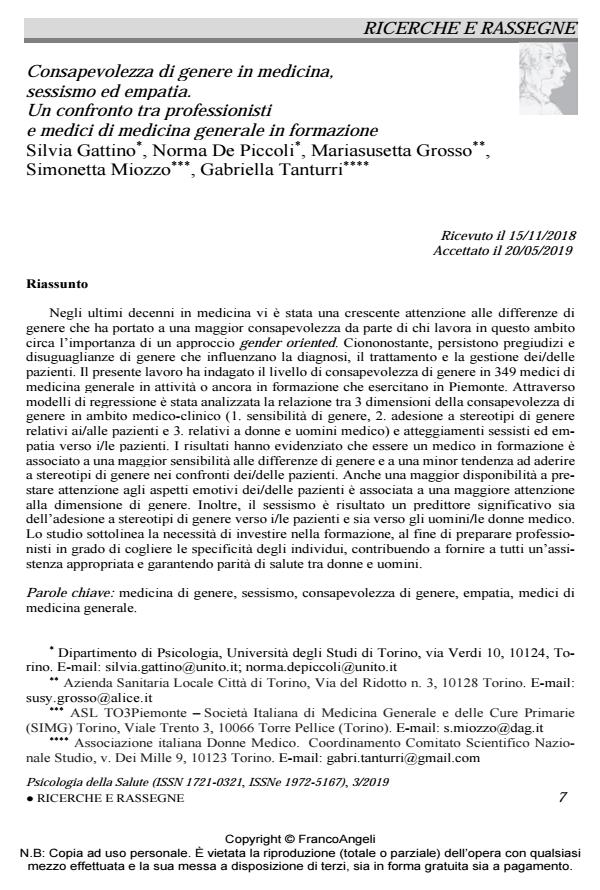Consapevolezza di genere in medicina, sessismo ed empatia. Un confronto tra professionisti e medici di medicina generale in formazione
Titolo Rivista PSICOLOGIA DELLA SALUTE
Autori/Curatori Silvia Gattino, Norma De Piccoli, Mariasusetta Grosso, Simonetta Miozzo, Gabriella Tanturri
Anno di pubblicazione 2019 Fascicolo 2019/3
Lingua Italiano Numero pagine 21 P. 7-27 Dimensione file 284 KB
DOI 10.3280/PDS2019-003002
Il DOI è il codice a barre della proprietà intellettuale: per saperne di più
clicca qui
Qui sotto puoi vedere in anteprima la prima pagina di questo articolo.
Se questo articolo ti interessa, lo puoi acquistare (e scaricare in formato pdf) seguendo le facili indicazioni per acquistare il download credit. Acquista Download Credits per scaricare questo Articolo in formato PDF

FrancoAngeli è membro della Publishers International Linking Association, Inc (PILA)associazione indipendente e non profit per facilitare (attraverso i servizi tecnologici implementati da CrossRef.org) l’accesso degli studiosi ai contenuti digitali nelle pubblicazioni professionali e scientifiche
Negli ultimi decenni in medicina vi è stata una crescente attenzione alle differenze di genere che ha portato a una maggior consapevolezza da parte di chi lavora in questo ambito circa l’importanza di un approccio gender oriented. Ciononostante, persistono pregiudizi e disugua-glianze di genere che influenzano la diagnosi, il trattamento e la gestione dei/delle pazienti. Il presente lavoro ha indagato il livello di consapevolezza di genere in 349 medici di medicina generale in attività o ancora in formazione che esercitano in Piemonte. Attraverso modelli di regressione è stata analizzata la relazione tra 3 dimensioni della consapevolezza di genere in ambito medico-clinico (1. sensibilità di genere, 2. adesione a stereotipi di genere relativi ai/alle pazienti e 3. relativi a donne e uomini medico) e atteggiamenti sessisti ed empatia verso i/le pazienti. I risultati hanno evidenziato che essere un medico in formazione è associato a una maggior sensibilità alle differenze di genere e a una minor tendenza ad aderire a stereotipi di genere nei confronti dei/delle pazienti. Anche una maggior disponibilità a prestare attenzione agli aspetti emotivi dei/delle pazienti è associata a una maggiore attenzione alla dimensione di genere. Inoltre, il sessismo è risultato un predittore significativo sia dell’adesione a stereotipi di genere verso i/le pazienti e sia verso gli uomini/le donne medico. Lo studio sottolinea la neces-sità di investire nella formazione, al fine di preparare professionisti in grado di cogliere le specificità degli individui, contribuendo a fornire a tutti un’assistenza appropriata e garantendo parità di salute tra donne e uomini.
Parole chiave:Medicina di genere, sessismo, consapevolezza di genere, empatia, medici di medicina generale.
- Lingua inclusiva: forme, funzioni, atteggiamenti e percezioni Kevin De Vecchis, (ISBN:978-88-6969-866-8)
- Turkish Adaptation and Psychometric Properties of Nıjmegen Gender Awareness in Medicine Scale: Assessment of Validity and Relıability İmran Gökçen YILMAZ KARAMAN, Cennet YASTIBAŞ, Ali Ercan ALTINÖZ, İrem Naz ÖRNEKEL, Muzaffer BİLGİN, Gulcan GULEC, in Konuralp Tıp Dergisi /2023 pp.429
DOI: 10.18521/ktd.1294869
Silvia Gattino, Norma De Piccoli, Mariasusetta Grosso, Simonetta Miozzo, Gabriella Tanturri, Consapevolezza di genere in medicina, sessismo ed empatia. Un confronto tra professionisti e medici di medicina generale in formazione in "PSICOLOGIA DELLA SALUTE" 3/2019, pp 7-27, DOI: 10.3280/PDS2019-003002